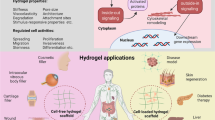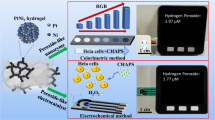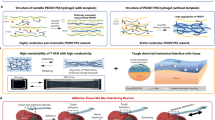Abstract
Molecular hydrogen (H2) protects organs from reactive oxygen species damage associated with ischemia–reperfusion (I/R) injury. Existing H2 delivery methods, such as gas inhalation and H2-rich water consumption, target the entire body and experience leakage during administration. Here we engineer a portable hydrogel electrochemical cell that enables on-demand H2 production via the hydrogen evolution reaction. The system enables H2 controlled generation, localized storage and sustained diffusion to the tissue–device interface, with better controllability and sustainability. We conduct a thorough study of H2 evolution and dynamics in the hydrogel system, evaluating the influence of hydrogel polymer composition on the hydrogen evolution reaction kinetics, bubble morphologies and storage. We validate its protective effects (1) in vitro with cardiomyocytes and keratinocytes, (2) ex vivo in I/R hearts and (3) in vivo in skin I/R pressure ulcers. These findings demonstrate the potential of the hydrogel electrochemical cell design for efficient and sustainable H2 delivery in I/R therapy, which could be broadly applied in other gas-based therapies and drug delivery research.

This is a preview of subscription content, access via your institution
Access options
Subscribe to this journal
Receive 12 digital issues and online access to articles
$119.00 per year
only $9.92 per issue
Buy this article
- Purchase on SpringerLink
- Instant access to full article PDF
Prices may be subject to local taxes which are calculated during checkout





Similar content being viewed by others
Data availability
The research findings presented in this study are supported by data included in the Article and Supplementary Information. Source data are provided with this paper and are publicly available via GitHub at https://github.com/wenli-web/Hydrogen-evolution-in-hydrogel-electrochemical-cell/tree/main.
Code availability
Scripts used for data analysis and Bluetooth user interface in this study are available via GitHub at https://github.com/wenli-web/Hydrogen-evolution-in-hydrogel-electrochemical-cell/tree/main.
References
Cullen, D. A. et al. New roads and challenges for fuel cells in heavy-duty transportation. Nat. Energy 6, 462–474 (2021).
Li, M. et al. Environment molecules boost the chemoselective hydrogenation of nitroarenes on cobalt single-atom catalysts. ACS Catal. 12, 11960–11973 (2022).
Ohsawa, I. et al. Hydrogen acts as a therapeutic antioxidant by selectively reducing cytotoxic oxygen radicals. Nat. Med. 13, 688–694 (2007).
Gunathilake, C. et al. A comprehensive review on hydrogen production, storage, and applications. Chem. Soc. Rev. 53, 10900–10969 (2024).
Nie, C. et al. Hydrogen gas inhalation alleviates myocardial ischemia-reperfusion injury by the inhibition of oxidative stress and NLRP3-mediated pyroptosis in rats. Life Sci. 272, 119248 (2021).
Zhang, Y. et al. Effects of hydrogen-rich water on depressive-like behavior in mice. Sci. Rep. 6, 23742 (2016).
Shao, A. et al. Hydrogen-rich saline attenuated subarachnoid hemorrhage-induced early brain injury in rats by suppressing inflammatory response: possible involvement of NF-κB pathway and NLRP3 inflammasome. Mol. Neurobiol. 53, 3462–3476 (2016).
Ge, L., Yang, M., Yang, N.-N., Yin, X.-X. & Song, W.-G. Molecular hydrogen: a preventive and therapeutic medical gas for various diseases. Oncotarget 8, 102653–102673 (2017).
Chen, S. et al. Photocatalytic glucose depletion and hydrogen generation for diabetic wound healing. Nat. Commun. 13, 5684 (2022).
Chen, H. et al. Symbiotic algae–bacteria dressing for producing hydrogen to accelerate diabetic wound healing. Nano Lett. 22, 229–237 (2022).
Wang, B. et al. Magnesium implantation as a continuous hydrogen production generator for the treatment of myocardial infarction in rats. Sci. Rep. 14, 10959 (2024).
Yang, N. et al. Magnesium galvanic cells produce hydrogen and modulate the tumor microenvironment to inhibit cancer growth. Nat. Commun. 13, 2336 (2022).
Zhou, T. et al. 3D printable high-performance conducting polymer hydrogel for all-hydrogel bioelectronic interfaces. Nat. Mater. 22, 895–902 (2023).
Shen, Q. et al. Liquid metal-based soft, hermetic, and wireless-communicable seals for stretchable systems. Science 379, 488–493 (2023).
Liu, L., Chakma, A. & Feng, X. Gas permeation through water-swollen hydrogel membranes. J. Membr. Sci. 310, 66–75 (2008).
Smiljanić, M. et al. Improving the HER activity and stability of Pt nanoparticles by titanium oxynitride support. ACS Catal. 12, 13021–13033 (2022).
Cowley, B. A. & Woodward, B. A healthy future: platinum in medical applications: platinum group metals enhance the quality of life of the global population. Platin. Met. Rev. 55, 98–107 (2011).
Wang, Y. et al. Monolayered platinum nanoparticles as efficient electrocatalysts for the mass production of electrolyzed hydrogen water. Sci. Rep. 10, 10126 (2020).
Lu, Z. et al. Ultrahigh hydrogen evolution performance of under-water “superaerophobic” MoS2 nanostructured electrodes. Adv. Mater. 26, 2683–2687 (2014).
Zhao, X., Ren, H. & Luo, L. Gas bubbles in electrochemical gas evolution reactions. Langmuir 35, 5392–5408 (2019).
Mazloomi, S. K. & Sulaiman, N. Influencing factors of water electrolysis electrical efficiency. Renew. Sustain. Energy Rev. 16, 4257–4263 (2012).
Watanabe, S. et al. Protective effect of inhalation of hydrogen gas on radiation-induced dermatitis and skin injury in rats. J. Radiat. Res. 55, 1107–1113 (2014).
Gao, Q. et al. Molecular hydrogen increases resilience to stress in mice. Sci. Rep. 7, 9625 (2017).
de Almeida, A. J. P. O. et al. ROS: basic concepts, sources, cellular signaling, and its implications in aging pathways. Oxid. Med. Cell. Longev. 2022, 1225578 (2022).
Minutoli, L. et al. ROS-mediated NLRP3 inflammasome activation in brain, heart, kidney, and testis ischemia/reperfusion injury. Oxid. Med. Cell. Longev. 2016, 2183026 (2016).
Heusch, G. Myocardial ischaemia–reperfusion injury and cardioprotection in perspective. Nat. Rev. Cardiol. 17, 773–789 (2020).
Hausenloy, D. J. & Yellon, D. M. Ischaemic conditioning and reperfusion injury. Nat. Rev. Cardiol. 13, 193–209 (2016).
Herr, D. J., Aune, S. E. & Menick, D. R. Induction and assessment of ischemia-reperfusion injury in Langendorff-perfused rat hearts. J. Vis. Exp. 27, e52908 (2015).
Bugger, H. & Pfeil, K. Mitochondrial ROS in myocardial ischemia reperfusion and remodeling. Biochim. Biophys. Acta Mol. Basis Dis. 1866, 165768 (2020).
Vogel, B., Mehta, S. R. & Mehran, R. Reperfusion strategies in acute myocardial infarction and multivessel disease. Nat. Rev. Cardiol. 14, 665–678 (2017).
Boyko, T. V., Longaker, M. T. & Yang, G. P. Review of the current management of pressure ulcers. Adv. Wound Care 7, 57–67 (2018).
Gawlitta, D., Oomens, C. W. J., Bader, D. L., Baaijens, F. P. T. & Bouten, C. V. C. Temporal differences in the influence of ischemic factors and deformation on the metabolism of engineered skeletal muscle. J. Appl. Physiol. 103, 464–473 (2007).
Kumar, S., Theis, T., Tschang, M., Nagaraj, V. & Berthiaume, F. Reactive oxygen species and pressure ulcer formation after traumatic injury to spinal cord and brain. Antioxidants 10, 1013 (2021).
Stadler, I., Zhang, R.-Y., Oskoui, P., Whittaker, M. B. S. & Lanzafame, R. J. Development of a simple, noninvasive, clinically relevant model of pressure ulcers in the mouse. J. Invest. Surg. 17, 221–227 (2004).
Lee, I. et al. Electrocatalytic on-site oxygenation for transplanted cell-based-therapies. Nat. Commun. 14, 7019 (2023).
Krishnan, S. R. et al. A wireless, battery-free device enables oxygen generation and immune protection of therapeutic xenotransplants in vivo. Proc. Natl Acad. Sci. USA 120, e2311707120 (2023).
Wang, M. et al. A wearable electrochemical biosensor for the monitoring of metabolites and nutrients. Nat. Biomed. Eng. 6, 1225–1235 (2022).
Jiang, Y. et al. Wireless, closed-loop, smart bandage with integrated sensors and stimulators for advanced wound care and accelerated healing. Nat. Biotechnol. 41, 652–662 (2023).
Simons, P., Schenk, S. A., Gysel, M. A., Olbrich, L. F. & Rupp, J. L. M. A ceramic-electrolyte glucose fuel cell for implantable electronics. Adv. Mater. 34, 2109075 (2022).
Park, Y. J. et al. Electrodeposition of high-surface-area IrO2 films on Ti felt as an efficient catalyst for the oxygen evolution reaction. Front. Chem. 8, 593272 (2020).
Li, P. et al. Monolithic silicon for high spatiotemporal translational photostimulation. Nature 626, 990–998 (2024).
Prominski, A. et al. Porosity-based heterojunctions enable leadless optoelectronic modulation of tissues. Nat. Mater. 21, 647–655 (2022).
Shi, J. et al. Monolithic-to-focal evolving biointerfaces in tissue regeneration and bioelectronics. Nat. Chem. Eng. 1, 73–86 (2024).
Acknowledgements
We thank K. M. Watters for scientific editing of the manuscript, Z. Zhou for providing H2 for GC calibration, and J. Solaway for helpful insights and discussion. B.T. acknowledges support from the US Army Research Office (W911NF-24-1-0053), the National Institute of Health (1R01EB036091-01) and the National Science Foundation (NSF CBET-2422962 and NSF OMA-2121044). L.J. acknowledges support from the National Science Foundation (NSF CMMI-2403592). This work used computational and storage services associated with the Hoffman2 Shared Cluster provided by the Institute for Digital Research and Education’s Research Technology Group at the University of California, Los Angeles. We would like to thank the University of Chicago Animal Resources Center (RRID: SCR_021806). This work made use of the Pritzker Nanofabrication Facility at the Pritzker School of Molecular Engineering at the University of Chicago, which receives support from the Soft and Hybrid Nanotechnology Experimental (SHyNE) Resource (NSF ECCS-2025633), a node of the National Science Foundation’s National Nanotechnology Coordinated Infrastructure (RRID: SCR_022955). Parts of this work were carried out at the Soft Matter Characterization Facility and Integrated Small Animal Imaging Research Resource (iSAIRR imaging center) of the University of Chicago.
Author information
Authors and Affiliations
Contributions
B.T. supervised the research. W.L. and B.T. initiated and conceived the hydrogel electrochemical cell concept. W.L. conducted most of the data collection on materials synthesis, characterization and in vivo rodent experiments. W.L. designed and fabricated all the devices. J.Z. and W.L. conducted most of the data collection for the in vitro cell and ex vivo heart experiments. R.N., P. Lopes and T.G. assisted W.L. with the electronics design. J.Y. assisted with the in vivo rodent experiments. A.K. assisted with the diffusion simulation. C.W. and L.J. assisted with the mechanical simulation for bubble morphology. H.-M.T. assisted with the CT characterization. B.L., C.Y., P. Li, C.S. and S.K. assisted with the materials preparation and characterization. W.L. and J.Z. conducted all the subsequent data analysis. L.L.S. provided insight in manuscript preparation. W.L., J.Z. and B.T. prepared the manuscript, with input from all other authors.
Corresponding authors
Ethics declarations
Competing interests
The work highlighted in this manuscript is the subject of a pending patent application filed with the USPTO and owned by The University of Chicago. B.T. and W.L. are the inventors. A company called hPad was established based on the work. The other authors declare no competing interests.
Peer review
Peer review information
Nature Chemical Engineering thanks Seung-Pyo Lee, Yi Zhang, Yunlong Zhao and the other, anonymous, reviewer(s) for their contribution to the peer review of this work.
Additional information
Publisher’s note Springer Nature remains neutral with regard to jurisdictional claims in published maps and institutional affiliations.
Supplementary information
Supplementary Information
Supplementary Tables 1 and 2, Figs. 1–51, Captions for Supplementary Videos 1–7 and Methods.
Supplementary Video 1
Ti wire in solution producing H2 with 0.5-mA charge for 5 min. The video is played at 10× speed.
Supplementary Video 2
Ti wire in 3% hydrogel producing H2 with 0.5-mA charge for 5 min. The video is played at 10× speed.
Supplementary Video 3
Ti wire in 6% hydrogel producing H2 with 0.5-mA charge for 5 min. The video is played at 10× speed.
Supplementary Video 4
Ti wire in 10% hydrogel producing H2 with 0.5-mA charge for 5 min. The video is played at 10× speed.
Supplementary Video 5
Ti wire in 3% PVA solution producing H2 with 0.5-mA charge for 3 min. The video is played at 10× speed.
Supplementary Video 6
Ti wire–hydrogel–air interface producing H2 with 0.5-mA charge. The hydrogel is 10%. The video is played at 10× speed.
Supplementary Video 7
MEA–hydrogel device flame exposure test after 5-mA, 6-min charging.
Source data
Source Data Fig. 2
Statistical source data.
Source Data Fig. 3
Statistical source data.
Source Data Fig. 4
Statistical source data, and raw data of the LVP and ECG signals.
Source Data Fig. 5
Statistical source data.
Rights and permissions
Springer Nature or its licensor (e.g. a society or other partner) holds exclusive rights to this article under a publishing agreement with the author(s) or other rightsholder(s); author self-archiving of the accepted manuscript version of this article is solely governed by the terms of such publishing agreement and applicable law.
About this article
Cite this article
Li, W., Zhang, J., Nith, R. et al. Hydrogen evolution and dynamics in hydrogel electrochemical cells for ischemia–reperfusion therapy. Nat Chem Eng 2, 484–497 (2025). https://doi.org/10.1038/s44286-025-00259-x
Received:
Accepted:
Published:
Issue date:
DOI: https://doi.org/10.1038/s44286-025-00259-x
This article is cited by
-
Hydrogen therapy for ischemic injuries
Nature Chemical Engineering (2025)



